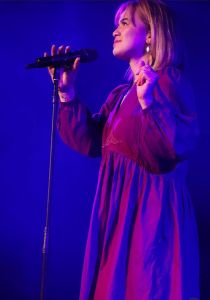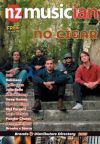X-Factory: Mahina Lawrence – Not The Same
X-Factory: Mahina Lawrence – Not The Same
Hawkes Bay singer-songwriter Mahina Lawrence has ticked off some impressive accomplishments early into her career. She was a national finalist in the 2019 competition to take up lead vocal duties for reggae group Tomorrow People, and in 2023 her debut single 7 Seas reached #7 on the Hot 20 Aotearoa Singles chart.
Earlier this year she released a follow up single, Not The Same, co-written with members from Tomorrow People, and recently took home the award for Best Māori Songwriter, along with Best Single by a Māori Artist, at the 2024 Waiata Māori Music Awards.
What struck me about Not The Same the first time I listened to it was how effortlessly the ear is guided through the song. There’s a clear sense of direction and forward momentum, despite the fact that there is limited harmonic movement (it’s the same two chords repeating in a four-bar loop), and the texture and groove remain consistent throughout the track, minus a few one or two-bar variations. The form also consists of just a verse and chorus (repeated) with a short intro and outro.
While the music production is certainly tasteful and polished, there is limited contrast to help guide the listener through the song. This is not to say there’s no contrast at all, there’s actually quite a lot, it’s just that nearly all of the contrast exists in the vocal melody. Contrast not only provides further layers of interest, it also helps steer the listener, acting as an aural sign post that says, ‘We’re going this way to a different spot… follow me.’ A song with no contrast not only sounds repetitive it can also sound like it lacks direction.
Not The Same is a great example of how a number of subtle changes to the melody can provide a sense of movement and direction, even when everything else stays largely the same. This could be helpful for all the budding songwriters out there, especially when working on a song with a small harmonic palette and minimal changes in texture. So, let’s take a deep dive into the vocal melody and see what’s going on.
Rhythmic Placement
The first phrase (A) of the song starts right on the downbeat of bar 1 and is just over three bars long, leaving verbal space in the latter part of bar 4. (Fig. 1).
Fig. 1. Verse melody bars 1-4
This structure repeats for the second phrase, but phrase 3 (B), halfway through the verse, begins with a pick-up, coming earlier than anticipated and giving just a small rhythmic push that effectively shifts the phrase forward, while still leaving the verbal space at the end of the phrase. This is the first little aural signpost that says, ‘We’re heading into a different bit.’ (Fig. 2).
Fig. 2. Verse melody bars 5-12
The final phrase of the verse follows the same pattern as the third. However, as we move into the chorus we get another rhythmic shift. Phrase 1 (C) of the chorus starts the same way as the previous ones with a pick-up on the ‘and’ of 3 but the verbal space has moved to the middle of the phrase (surrounding the rhyming word) rather than the end, and the phrase length has been condensed to two bars instead of three (Fig. 3). This structure is repeated for the second phrase and varied slightly for the third. These subtle shifts in rhythmic placement help provide a sense of direction, and the way they are grouped (AA, BB, CCC) provides a great balance of variety within an overall sense of unity. Also note the odd number of phrases in the chorus, creating a degree of instability in contrast to the very stable verse sections.
Fig. 3. Chorus melody.
Melodic Register
The rhythmic changes discussed above occur simultaneously with changes in melodic register. Phrases 1 and 2 (AA) of the verse are based around C#, the 3rd of the underlying Amaj7 chord, and have a range of one octave, from G#3 to G#4 (Fig. 1). As the rhythm changes in phrase 3 there is also a shift in register. Phrase 3 and 4 (BB) are more arch shaped than the stepwise motion of the previous phrases, and the opening gesture climbs up to an E, the 5th of the chord, with a range from B3 to B4, resulting in a slight upward lift (Fig. 2).
As we move into the chorus (CCC) the opening gesture shifts upward again to a G#, the 7th of the chord (Fig. 3). As the song progresses through the verse and chorus, the focal melody note moves higher up the chord tones of the underlying Amaj7 chord, creating a sense of upward movement.
 Word Setting
Word Setting
Let’s take a look at how the lyrics are set to a rhythm. Following the same AA, BB, CCC structure as earlier further contrast is created by the manner in which the sentences are broken up with rhythmic pauses. The opening lines (AA) create a rhythmic space in the middle of what would be a complete phrase of text if spoken out loud:
Empty places, blinding faces as I [pause] embrace the light.
Walls are closing, statues posing I try [pause] to face the night
The second half of the verse (BB) shifts and the pauses now land where they naturally would if spoken:
As it’s coming for me, [pause] makes it harder for me to let go
It’s reality, [pause] feels like I can’t breathe and it shows
And finally, the chorus (CCC) is different again, creating two pauses in what is an otherwise complete thought:
Though I try [pause] to [pause] ease up the pain
As I cry [pause] through [pause] the thundering rain
Can I fly [pause] through [pause] it’s not the same without you
Syllabic and Melismatic
A melisma is when two or more notes are sung on a single syllable, and notice how they are used differently throughout the sections. Phrase one and two of the verse (AA) make frequent use of melismas, giving it a loose and flowing feel (Fig. 1):
Emp(ty) places, blind(ing) faces as (I) em(brace) the (light)
Walls (are) closing, stat(ues) posing I (try) to (face) the (night)
In the second half of the verse (BB), they become less common, steering toward a more punctuated and direct lyrical message (Fig. 2):
As it’s coming (for) me makes it harder (for) me to let (go)
It’s rea(li)ty feels like I (can’t) breathe and it (shows)
In contrast, the chorus (CCC) is highly syllabic, resulting in a direct lyrical message that drives home the central point of the song. (Fig. 3)
Though I try to ease up the pain
As I cry through the thundering rain
Can I fly through it’s not the same without (you)
Summing Up
Each of these changes are subtle, but notice how they work together. Phrase one and two of the verse (AA) start on the downbeat, on a C#, with rhythmic pauses in unstable places, and frequent use of melismas. Phrases three and four (BB) begin with a pick up, rising to an E, with rhythmic pauses in stable places and become more syllabic. The phrases in the chorus (CCC) begin with a pickup, rise to G# and double-down on the unstable pauses while also being highly syllabic.
All these changes add up to a good amount of contrast, and therein lies the aural signposts, the things that steer us through the song while other areas such as harmony, groove and texture remain largely consistent so do not provide as much direction. These melodic techniques can be very powerful in any songwriting situation, but they are especially useful when working with a song that has limited harmonic movement or a relatively flat texture. They may just provide all the contrast you need.
Jeff Wragg composes popular and classical music, and also composes for film, television and theatre. He is also an educator and has held teaching positions at MAINZ, SIT and Victoria University. He can be contacted at www.jeffwragg.com




